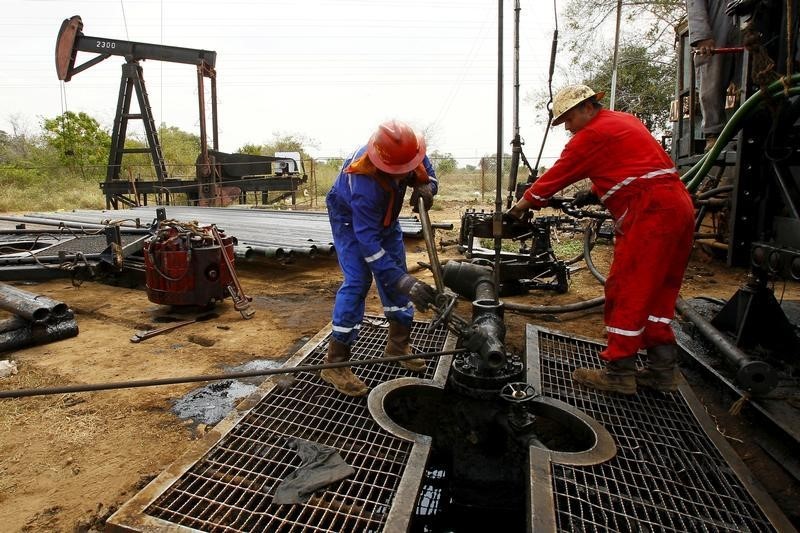HK-listed gold stocks jump as US economic fears boost bullion prices
* Brent set for small monthly fall, WTI for monthly gain
* Marketlink crude pipeline rates cut after Keystone
leak-sources
* Chinese factory activity shrinks for sixth month
* POLL-Oil prices face pressure as global economy slows
(Adds latest prices, U.S. Marketlink pipe disruption and
Keystone spill)
By Scott DiSavino
NEW YORK, Oct 31 (Reuters) - Oil prices were nearly 2% lower
on Thursday after a leak on a key U.S. pipeline disrupted supply
flows and on data showing weak factory activity in China.
Brent LCOc1 futures were down 40 cents, or 0.7%, at $60.21
a barrel by 12:08 p.m. EDT (1608 GMT), while U.S. West Texas
Intermediate crude CLc1 fell 94 cents, or 1.7%, to $54.12.
The front-month Brent contract for December delivery expires
on Thursday. Futures for January delivery LCOc2 were down
about 1.1% to $59.53.
For the month, Brent was on track to fall less than 1% and
WTI was on track to rise less than 1%.
In the United States, TC Energy Corp's TRP.TO 750,000
barrels per day (bpd) Marketlink crude pipeline from Cushing,
Oklahoma, to Nederland, Texas, was operating at reduced rates,
three sources said on Thursday, due to supply disruptions after
the TC Energy shut its Keystone pipeline after a leak in North
Dakota. Marketlink is connected to the 590,000-bpd Keystone oil
pipeline system, a key transporter of Canadian crude from
northern Alberta to refineries in the U.S. Midwest.
Traders said the Marketlink disruption pressured U.S. crude
prices lower by making it harder to move oil out of the Cushing
storage hub, which is the delivery point for WTI crude
contracts.
About 9,120 barrels of oil were estimated to have spilled
from Keystone after a leak was discovered late Tuesday,
according to state regulators in North Dakota.
In China, meanwhile, factory activity shrank for a sixth
straight month in October while growth in the country's service
sector activity was its slowest since February 2016, official
data showed on Thursday. A protracted trade war between China and the United States
has been weighing on the demand outlook for oil.
Leaders from the United States and China encountered a new
obstacle in their struggle to end the trade conflict when the
summit at which they were supposed to meet was cancelled because
of violent protests in Chile, the host nation. U.S. President Donald Trump tweeted a new location would be
announced soon. A Reuters survey showed that oil prices are likely to remain
pressured this year and next. The poll of 51 economists and
analysts forecast Brent crude would average $64.16 a barrel in
2019 and $62.38 next year. Releasing third-quarter results, Royal Dutch Shell Plc
RDSa.L warned that uncertain economic conditions could slow
its $25 billion share buyback programme, the world's largest,
and had led to a downward revision to its oil price outlook.
The U.S. Federal Reserve cut interest rates for a third time
this year on Wednesday, looking to bolster economic growth with
a move that could also boost demand for crude.
Yet gains are likely to be capped until inventories start to
show sustained declines.
U.S. crude inventories USOILC=ECI rose by 5.7 million
barrels in the week to Oct. 25, the U.S. Energy Information
Administration said on Wednesday, compared with analyst
expectations for a much smaller increase of just 494,000
barrels. EIA/S
"The U.S. stock report was anything but encouraging," PVM
analysts said in a note.
Cushioning the bearish crude data, the EIA showed gasoline
and distillate inventories continued to draw.
<^^^^^^^^^^^^^^^^^^^^^^^^^^^^^^^^^^^^^^^^^^^^^^^^^^^^^^^^^^^
CHART: Brent oil may fall further into $59.98-$60.30 range
IDn:L3N27G0RA
CHART: U.S. oil may retest support at $54.48 IDnL3N27G16K
GRAPHIC U.S. petroleum inventories https://tmsnrt.rs/2XlX17b
^^^^^^^^^^^^^^^^^^^^^^^^^^^^^^^^^^^^^^^^^^^^^^^^^^^^^^^^^^^>
